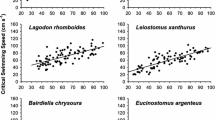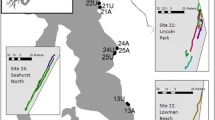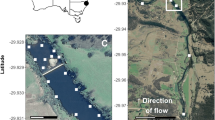Abstract
Anthropogenic water management projects and facilities that alter the local and regional hydrology of riverine environments greatly influence the behavior, physiology, and survival of native fishes. To mitigate for losses of native fishes at these structures, many are outfitted with fish-exclusion screens to reduce entrainment. The effect of fish size and age on behavior near fish screens, however, is largely unknown. Therefore, we tested two size classes of juvenile green sturgeon (Acipenser medirostris; small, early juveniles: 9.2 ± 0.2 cm fork length [FL], 6.9 ± 0.3 g; intermediate juveniles: 18.8 ± 0.2 cm FL, 36.9 ± 0.8 g) near fish-exclusion screens in a laboratory swimming flume. Although size was a significant factor influencing the way in which fish contacted the screens (i.e., proportion of body contacts, p = 2.5 × 10−9), it did not significantly influence the number of times fish contacted screens or the amount of time fish spent near screens. We also compared the performance of these two size classes to that of older and larger sturgeon that were tested previously (29.6 ± 0.2 cm FL, 147.1 ± 3.1 g), and documented a clear difference in the behavior of the fish that resulted in disparities in how the large fish contacted screens relative to small- or intermediate-sized juveniles (p = 0.005, 5.4 × 10−4, respectively). Our results further our understanding of how ontogeny affects fish behavior near anthropogenic devices, and are informative for managers seeking to identify the most susceptible size and age class of juvenile green sturgeon to water-diversion structures to potentially develop size-specific conservation strategies.


Similar content being viewed by others
References
Allen PJ, Cech JJ (2007) Age/size effects on juvenile green sturgeon, Acipenser medirostris, oxygen consumption, growth, and osmoregulation in saline environments. Environ Biol Fish 79:211–229. https://doi.org/10.1007/s10641-006-9049-9
Allen PJ, Cech JJ, Kültz D (2009) Mechanisms of seawater acclimation in a primitive, anadromous fish, the green sturgeon. J Comp Physiol B Biochem Syst Environ Physiol 179:903–920. https://doi.org/10.1007/s00360-009-0372-2
Allen PJ, Hodge B, Werner I, Cech JJ Jr (2006) Effects of ontogeny, season, and temperature on the swimming performance of juvenile green sturgeon (Acipenser medirostris). Can J Fish Aquat Sci 63:1360–1369. https://doi.org/10.1139/f06-031
Allen PJ, McEnroe M, Forostyan T et al (2011) Ontogeny of salinity tolerance and evidence for seawater-entry preparation in juvenile green sturgeon, Acipenser medirostris. J Comp Physiol B Biochem Syst Environ Physiol 181:1045–1062. https://doi.org/10.1007/s00360-011-0592-0
Boys CA, Baumgartner LJ, Lowry M (2013a) Entrainment and impingement of juvenile silver perch, Bidyanus bidyanus, and golden perch, Macquaria ambigua, at a fish screen: Effect of velocity and light. Fish Manag Ecol 20:362–373. https://doi.org/10.1111/fme.12026
Boys CA, Robinson W, Baumgartner LJ et al (2013b) Influence of Approach Velocity and Mesh Size on the Entrainment and Contact of a Lowland River Fish Assemblage at a Screened Irrigation Pump. PLoS One. https://doi.org/10.1371/journal.pone.0067026
Doroshov SI (1985) The biology and culture of sturgeon. In: Muir J, Roberts R (eds) Recent advances in aquaculture. Vol. 2. Croon Helm, London, England, pp 251–274
Dudgeon D, Arthington AH, Gessner MO et al (2006) Freshwater biodiversity: importance, threats, status and conservation challenges. Biol Rev Camb Philos Soc 81:163–182. https://doi.org/10.1017/S1464793105006950
Erickson DL, North JA, Hightower JE et al (2002) Movement and habitat use of green sturgeon Acipenser medirostris in the Rogue River, Oregon, USA. J Appl Ichthyol 18:565–569. https://doi.org/10.1046/j.1439-0426.2002.00403.x
Folmar LC, Dickhoff WW (1980) The parr—Smolt transformation (smoltification) and seawater adaptation in salmonids. Aquaculture 21:1–37. https://doi.org/10.1016/0044-8486(80)90123-4
Fox J, Weisberg S (2011) Multivariate Linear Models in R. An {R} Companion to Applied Regression, Second Edition. Sage, Thousand Oaks CA. URL: http://socserv.socsci.mcmaster.ca/jfox/Books/Companion
Gadomski DM, Parsley MJ (2005) Laboratory studies on the vulnerability of young white sturgeon to predation. North Am J Fish Manag 25:667–674. https://doi.org/10.1577/M03-220.1
Hardy RS, Litvak MK (2004) Effects of temperature on the early development, growth, and survival of shortnose sturgeon, Acipenser brevirostrum, and Atlantic sturgeon, Acipenser oxyrhynchus, yolk-sac larvae. Environ Biol Fish. 70:145–154
Herren JR, Kawasaki SS (2001) Inventory of water diversions in four geographic areas in California’s Central Valley. Fish Bull 179:343–355
Hoar WS (1988) The Physiology of Smolting Salmonids. Fish physiology 11:275–343
Horodysky AZ, Cooke SJ, Brill RW (2015) Physiology in the service of fisheries science: Why thinking mechanistically matters. Rev Fish Biol Fish 25:425–447. https://doi.org/10.1007/s11160-015-9393-y
Hothorn T, Bretz F, Westfall P (2008) Simultaneous inference in general parametric models. Biom J 50:346–363
Israel JA, Cordes JF, Blumberg MA, May B (2004) Geographic Patterns of Genetic Differentiation Among Collections of Green Sturgeon. North Am J Fish Manag 24:922–931. https://doi.org/10.1577/M03-085.1
Israel JA, Kimley AP (2008) Life History Conceptual Model for North American Green Sturgeon (Acipenser medirostris). Delta Reg Ecosyst Restor Implement Plan Rep 1–49
Johnson R, Simmons M, Mckinstry C, et al (2005) Strobe Light Deterrent Efficacy Test and Fish Behavior Determination at Grand Coulee Dam Third Powerplant Forebay. 139
Klimley AP, Chapman ED, Cech Jr, JJ, et al (2015) Sturgeon in the Sacramento–San Joaquin Watershed: New Insights to Support Conservation and Management. San Francisco Estuary and Watershed Science 13
Komoroske LM, Connon RE, Lindberg J et al (2014) Ontogeny influences sensitivity to climate change stressors in an endangered fish. Conserv Physiol 2:1–13. https://doi.org/10.1093/conphys/cou008
Kynard B, Henyey E, Horgan M (2002) Ontogenetic behavior, migration, and social behavior of pallid sturgeon, Scaphirhynchus albus, and shovelnose sturgeon, S. platorynchus, with notes on the adaptive significance of body color. Environ Biol Fish 63:389–403. https://doi.org/10.1023/A:1014950202783
Kynard B, Parker E, Parker T (2005) Behavior of early life intervals of Klamath River green sturgeon, Acipenser medirostris, with a note on body color. Environ Biol Fish 72:85–97. https://doi.org/10.1007/s10641-004-6584-0
Lundvall D, Svanbäck R, Persson L, Byström P (1999) Size-dependent predation in piscivores: interactions between predator foraging and prey avoidance abilities. Can J Fish Aquat Sci 56:1285–1292. https://doi.org/10.1139/f99-058
Maes J, Turnpenny AWH, Lambert DR et al (2004) Field evaluation of a sound system to reduce estuarine fish intake rates at a power plant cooling water inlet. J Fish Biol 64:938–946. https://doi.org/10.1111/j.1095-8649.2004.00360.x
Mallen-Cooper M (1984) Habitat changes and declines of freshwater fish in Australia: What is the evidence and do we need more? Bur Resour Sci Proc 118–123
Marchetti MP, Moyle PB (2001) Effects of flow regime on fish assemblages in a regulated California stream. Ecol Appl 11:530–539
Morita K, Yamamoto S (2002) Effects of habitat fragmentation by damming on the persistence of stream-dwelling charr populations. Conserv Biol 16:1318–1323. https://doi.org/10.1046/j.1523-1739.2002.01476.x
Mount J, Bennett W, Durand J, et al (2012) Aquatic Ecosystem Stressors in the Sacramento – San Joaquin Delta
Moyle PB, Leidy RA (1992) Loss of biodiversity in aquatic ecosystems: evidence from fish faunas. In Conservation biology (pp. 127-169). Springer US
Mussen TD, Cocherell D, Poletto JB et al (2014) Unscreened water-diversion pipes pose an entrainment risk to the threatened green sturgeon, acipenser medirostris. PLoS One 9:1–9. https://doi.org/10.1371/journal.pone.0086321
NMFS (2006) National Marine Fisheries Service Endangered and threatened wildlife and plants: proposed threatened status for Southern distinct population segment of North American green sturgeon Federal Register (2006), pp. 17757–17766
Noatch MR, Suski CD (2012) Non-physical barriers to deter fish movements. Environ Rev 20:71–82
Nobriga ML, Matica Z, Hymanson ZP (2004) Evaluating entrainment vulnerability to agricultural irrigation diversions: A comparison among open-water fishes. Am Fish Soc Symp 39:281–295
Peake S, Beamish FWH, Mckinley RS et al (1997) Relating swimming performance of lake sturgeon, Acipenser fulvescens, to fishway design. Can J Fish Aquat Sci 54:1361–1366. https://doi.org/10.1139/f97-039
Pohlert T (2014) The Pairwise Multiple Comparison of Mean Ranks Package (PMCMR). R package, http://CRAN.R-project.org/package=PMCMR
Poletto JB, Cocherell DE, Ho N et al (2014a) Juvenile green sturgeon (Acipenser medirostris) and white sturgeon (Acipenser transmontanus) behavior near water-diversion fish screens: experiments in a laboratory swimming flume. Can J Fish Aquat Sci 71:1030–1038. https://doi.org/10.1139/cjfas-2013-0556
Poletto JB, Cocherell DE, Mussen TD et al (2014b) Efficacy of a sensory deterrent and pipe modifications in decreasing entrainment of juvenile green sturgeon (Acipenser medirostris) at unscreened water diversions. Conserv Physiol 2:1–12. https://doi.org/10.1093/conphys/cou056
Poletto JB, Cocherell DE, Mussen TD et al (2015) Fish-protection devices at unscreened water diversions can reduce entrainment: Evidence from behavioural laboratory investigations. Conserv Physiol 3:1–12. https://doi.org/10.1093/conphys/cov040
Quinn TP, Myers KW (2004) Anadromy and the marine migrations of Pacific salmon and trout: Rounsefell revisited. Rev Fish Biol Fish 14:421–442. https://doi.org/10.1007/s11160-005-0802-5
Development Core Team R (2012) R: a language and environment for statisticalcomputing. R Foundation for Statistical Computing, Vienna
Sagera DR, Hocuttb CH, Jrc JRS et al (2000) Avoidance behavior of Morone americana, Leiostomus xanthurus and Brevoortia tyrannus to strobe light as a method of impingement mitigation. Environ Sci Pol 3:393–403. https://doi.org/10.1016/S1462-9011(00)00046-0
Schindler DW (2001) The cumulative effects of climate warming and other human stresses on Canadian freshwaters in the new millennium. Can J Fish Aquat Sci 58:18–29
Schrank AJ, Rahel FJ (2004) Movement patterns in inland cutthroat trout ( Oncorhynchus clarki utah ): management and conservation implications. Can J Fish Aquat Sci 61:1528–1537. https://doi.org/10.1139/f04-097
Seesholtz AM, Manuel MJ, Van Eenennaam JP (2015) First documented spawning and associated habitat conditions for green sturgeon in the Feather River, California. Environ Biol Fish 98:905–912. https://doi.org/10.1007/s10641-014-0325-9
Swanson C, Young PS, Cech JJ (2005) Close Encounters with a Fish Screen: Integrating Physiological and Behavioral Results to Protect Endangered Species in Exploited Ecosystems. Trans Am Fish Soc 134:1111–1123. https://doi.org/10.1577/T04-121.1
Swanson C, Young PS, Cech JJ (2004) Swimming in two-vector flows: Performance and behavior of juvenile Chinook salmon near a simulated screened water diversion. Trans Am Fish Soc 133:265–278. https://doi.org/10.1577/03-068
Taft EP (2000) Fish protection technologies: a status report. Environ Sci Pol 3:S349–S359. https://doi.org/10.1016/S1462-9011(00)00038-1
Van Eenennaam JP, MAH W, Deng X et al (2001) Artificial Spawning and Larval Rearing of Klamath River Green Sturgeon. Trans Am Fish Soc 130:159–165. https://doi.org/10.1577/1548-8659(2001)130<0159:ASALRO>2.0.CO;2
Verhille CE, Poletto JB, Cocherell DE et al (2014) Larval green and white sturgeon swimming performance in relation to water-diversion flows. Conserv Physiol 2:1–14. https://doi.org/10.1093/conphys/cou031
Veselov AE, Kazakov RV, Sysoyeva MI, Bahmet IN (1998) Ontogenesis of rheotactic and optomotor responses of juvenile atlantic salmon. Aquaculture 168:17–26. https://doi.org/10.1016/S0044-8486(98)00362-7
Wenger SJ, Isaak DJ, Luce CH et al (2011) Flow regime, temperature, and biotic interactions drive differential declines of trout species under climate change. Proc Natl Acad Sci U S A 108:14175–14180. https://doi.org/10.1073/pnas.1103097108
Werner EE, Hall DJ (1988) Ontogenetic habitat shifts in bluegill: the foraging rate-predation risk trade-off. Ecology 69:1352–1366
Wickham H (2009) ggplot2: Elegant Graphics for Data Analysis. Springer-Verlag, New York
Wickham H (2011).The Split-Apply-Combine Strategy for Data Analysis. J Stat Softw 40: 1-29. URL http://www.jstatsoft.org/v40/i01/
Wikelski M, Cooke SJ (2006) Conservation physiology. Trends Ecol Evol 21:38–46. https://doi.org/10.1016/j.tree.2005.10.018
Xenopoulos MA, Lodge DM, Alcamo J et al (2005) Scenarios of freshwater fish extinctions from climate change and water withdrawal\ndoi:10.1111/j.1365-2486.2005.001008.x. Glob Chang Biol 11:1557–1564. https://doi.org/10.1111/j.1365-2486.2005.01008.x
Young PS, Swanson C, Cech JJ (2010) Close Encounters with a Fish Screen III: Behavior, Performance, Physiological Stress Responses, and Recovery of Adult Delta Smelt Exposed to Two-Vector Flows near a Fish Screen. Trans Am Fish Soc 139:713–726. https://doi.org/10.1577/T09-029.1
Acknowledgements
We thank the numerous students and staff assistants of the Fangue Laboratory for assistance in fish rearing and maintenance, and in data acquisition and analysis. In particular, we thank Joel van Eenennaam for spawning the fish used in the study, and the Yurok Tribe for donating the broodstock green sturgeon from which the juveniles were spawned. Funding for the work was provided by the California Department of Fish and Wildlife’s Ecosystem Restoration Program (Grant #E0783004 to APK and NAF), the University of California Agricultural Experimental Station (Grant #2098-H to NAF), and a Delta Stewardship Council Grant (Grant #1470 to NAF and JBP). JBP was supported in part by an NSF Graduate Research Fellowship. We also would like to thank two anonymous reviewers for their helpful suggestions to improve this manuscript.
Author information
Authors and Affiliations
Corresponding author
Rights and permissions
About this article
Cite this article
Poletto, J.B., Cocherell, D.E., Ho, N. et al. The effect of size on juvenile green sturgeon (Acipenser medirostris) behavior near water-diversion fish screens. Environ Biol Fish 101, 67–77 (2018). https://doi.org/10.1007/s10641-017-0681-3
Received:
Accepted:
Published:
Issue Date:
DOI: https://doi.org/10.1007/s10641-017-0681-3




